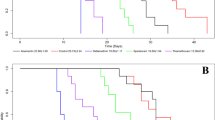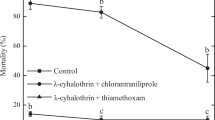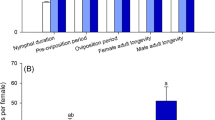Abstract
This study assessed the transgenerational effects of insecticides in developing Trichogramma galloi (Hymenoptera: Trichogrammatidae). Laboratory bioassays were performed in which five insecticides were sprayed on egg-larval, pre-pupal and pupal stages of the parasitoid. The interaction between insecticides and development stages of the parasitoid was not significant for the rate of F0 emergence. All insecticides significantly reduced the emergence of wasps, with the lowest emergence observed when they were applied to the pupal stage. For the sex ratio, only spinosad applied to the pre-pupal stage and triflumuron applied on the egg-larval and pre-pupal stages did not differ from the controls. Triflumuron applied to pre-pupae did not lead to any difference in the parasitism rate of the treated generation (F0) when compared to the control. There were no significant differences among survival curves for females of F0 when all insecticides were sprayed on the egg-larval stage. Both concentrations of lambda-cyhalothrin + thiamethoxam reduced female pre-pupal survival, and all treatments reduced female pupal survival. In addition, we observed a transgenerational effect of the insecticides on emergence and sex ratio of next generation (F1). Lambda-cyhalothrin + thiamethoxam (Min) applied to the pre-pupae and pupae, the maximum rate of the same insecticides applied to the egg-larvae and pre-pupae, and spinosad applied to pre-pupae all significantly reduced the adults emergence of T. galloi F1 generation. Only triflumuron did not alter the F1 sex ratio. These bioassays provide a basis for better understanding the effects of insecticide use on beneficial parasitoids.




Similar content being viewed by others
References
Ali A, Ahmad F, Biondi A, Wang Y, Desneux N (2012) Potential for using Datura alba leaf extracts against two major stored grain pests, the khapra beetle Trogoderma granarium and the rice weevil Sitophillus oryzae. J Pest Sci 85:359–366
Biondi A, Mommaerts V, Smagghe G, Viñuela E, Zappalà L, Desneux N (2012a) The non-target impact of spinosyns on beneficial arthropods. Pest Manag Sci 68:1523–1536
Biondi A, Desneux N, Siscaro G, Zappalà L (2012b) Using organic-certified rather than synthetic pesticides may not be safer for biological control agents: selectivity and side effects of 14 pesticides on the predator Orius laevigatus. Chemosphere 87:803–812
Biondi A, Zappalà L, Stark JD, Desneux N (2013) Do biopesticides affect the demographic traits of a parasitoid wasp and its biocontrol services through sublethal effects? PLoS ONE 8:e76548
Carvalho GA, Reis PR, Moraes JC, Fuini LC, Rocha LCD, Goussain MM (2002) Efeitos de alguns inseticidas utilizados na cultura do tomateiro (Lycopersicon esculentum Mill.) a Trichogramma pretiosum Riley, 1879 (Hymenoptera: Trichogrammatidae). Ciênc Agrotec 26:1160–1166
Carvalho GA, Godoy MS, Parreira DS, Rezende DT (2010) Effect of chemical insecticides used in tomato crops on immature Trichogramma pretiosum (Hymenoptera: Trichogrammatidae). Rev Colomb Entomol 36:10–15
Chailleux A, Desneux N, Seguret J, Khanh HDT, Maignet P, Tabone E (2012) Assessing European egg parasitoids as a mean of controlling the invasive South American tomato pinworm Tuta absoluta. PLoS ONE 7:e48068
Chailleux A, Bearez P, Pizzol J, Amiens-Desneux E, Ramirez-Romero R, Desneux N (2013) Potential for combining indigenous natural enemies for biological control of the key invasive tomato pest, Tuta absoluta, in Afro-Eurasia. J Pest Sci 86:533–541
Cohen E (2010) Chitin biochemistry: synthesis, hydrolysis and inhibition. In: Jérôme C, Stephens JS (eds) Advances in insect physiology. Academic, London, pp 5–74
Cônsoli FL, Rossi MM, Parra JRP (1999) Development time and characteristics of the immature stages of Trichogramma galloi and T. pretiosum (Hymenoptera, Trichogrammatidae). Rev Bras Entomol 43:271–275
Cônsoli FL, Botelho PSM, Parra JRP (2001) Selectivity of insecticides to the egg parasitoid Trichogramma galloi Zucchi, 1988, (Hym., Trichogrammatidae). J Appl Entomol 125:37–43
Croft BA (1990) Arthropod biological control agents and pesticides. Wiley, New York
Daam MA, Van den Brink PJ (2010) Implications of differences between temperate and tropical freshwater ecosystems for the ecological risk assessment of pesticides. Ecotoxicology 19:24–37
Delpuech JM, Meyet J (2003) Reduction in the sex ratio of the progeny of a parasitoid wasp (Trichogramma brassicae) surviving the insecticide chlorpyrifos. Arch Environ Contam Toxicol 45:203–208
Desneux N, Decourtye A, Delpuech JM (2007) The sublethal effects of pesticides on beneficial arthropods. Annu Rev Entomol 52:81–106
Dias-Pini NS, Broglio SMF, Costa SS, Santos JN, Guzzo EC (2012) Biological characteristics of Telenomus alecto and Trichogramma galloi reared on eggs of the sugarcane borer Diatraea flavipennella. Rev Bras Entomol 56:515–518
Gardner J, Hoffmann MP, Pitcher SA, Harper JK (2011) Integrating insecticides and Trichogramma ostriniae to control European corn borer in sweet corn: economic analysis. Biol Control 56:9–16
Guo L, Desneux N, Sonoda S, Liang P, Han P, Gao XW (2013) Sublethal and transgenerational effects of chlorantraniliprole on biological traits of the diamondback moth Plutella xylostella. Crop Prot 48:29–34
Hassan SA (1998) Guidelines for the evaluation of side effects of plant protection products on Trichogramma cacoeciae Marchal (Hym., Trichogrammatida). IOBC/WPRS Bull 21:119–128
Hassan SA, Hafes B, Degrande PE, Herai K (1998) The side-effects of pesticides on the egg parasitoid Trichogramma cacoeciae Marchal (Hym., Trichogrammatidae), acute dose-response and persistence tests. J Appl Entomol 122:569–573
Hoffmann EJ, Middleton SM, Wise JC (2008) Ovicidal activity of organophosphate, oxadiazine, neonicotinoid and insect growth regulator chemistries on northern strain plum curculio, Conotrachelus nenuphar. J Insect Sci 8:1–6
Hussain D, Akram M, Iqbal Z, Ali A, Saleem M (2010) Effect of some insecticides on Trichogramma chilonis Ishii. (Trichogrammatidae: Hymenoptera) immature and adult survival. J Agric Res 48:531–537
IRAC Insecticide Resistance Action Committee (2012) Mode of action classification: insecticide resistance management. http://www.irac-online.org/content/uploads/MoA-Brochure_ed-3.5_21Feb12.pdf. Accessed 20 March 2013
James DG (2002) Selectivity of the acaricide, bifenazate, and aphicide, pymetrozine, to spider mite predators in Washington hops. Int J Acarol 28:175–179
Johnson MW, Tabashnik BE (1999) Enhanced biological control through pesticide selectivity. In: Fisher T, Bellows TS, Caltagirone LE, Dahlsten DL, Huffaker C, Gordh G (eds) Handbook of biological control. Academic, San Diego, pp 297–317
Kim SW, Kwak J, An YJ (2013) Multigenerational study of gold nanoparticles in Caenorhabditis elegans: transgenerational effect of maternal exposure. Environ Sci Technol 47:5393–5399
Liu TX, Zhang Y (2012) Side effects of two reduced-risk insecticides, indoxacarb and spinosad, on two species of Trichogramma (Hymenoptera: Trichogrammatidae) on cabbage. Ecotoxicology 21:2254–2263
Maia JB, Carvalho GA, Leite MIS, Oliveira RL, Makyama L (2010) Selectivity of insecticides used in corn crops to adult Trichogramma atopovirilia (Hymenoptera: Trichogrammatidae). Rev Colomb Entomol 36:202–206
Marini RP (2003) Approaches to analyzing experiments with factorial arrangements of treatments plus other treatments. Hort Science 38:117–120
Merzendorfer H (2013) Chitin synthesis inhibitors: old molecules and new developments. Insect Sci 20:121–138
Mills N (2010) Egg parasitoids in biological control and integrated pest management. In: Cônsoli FL, Parra JRP, Zucchi RA (eds) Egg parasitoids in agroecosystems with emphasis on Trichogramma, 1st edn. Springer, Dordrecht, pp 389–411
Ministério da Agricultura, Pecuária e Abastecimento (2013) AGROFIT: sistema de agrotóxicos fitossanitários. Coordenação Geral de Agrotóxicos e Afins/DFIA/DAS, Brasília, Brazil. http://extrant.agricultura.gov.br/agrofit_cons/principal_agrofit_cons. Accessed 17 March 2013
Moscardini VF, Moura AP, Carvalho GA, Lasmar O (2008) Efeito residual de inseticidas sintéticos sobre Trichogramma pretiosum Riley (Hym., Trichogrammatidae) em diferentes gerações. Acta Sci Agron 30:177–182
Moscardini VF, Gontijo PC, Carvalho GA, Oliveira RL, Maia JB, Silva FF (2013) Toxicity and sublethal effects of seven insecticides to eggs of the flower bug Orius insidiosus (Say) (Hemiptera: Anthocoridae). Chemosphere 92:490–496
Narahashi T, Zhao X, Ikeda T, Nagata N, Yeh JZ (2007) Differential actions of insecticides on target sites: basis for selective toxicity. Hum Exp Toxicol 26:361–366
Oliveira CM, Auad AM, Mendes SM, Frizzas MR (2014) Crop losses and the economic impact of insect pests on Brazilian agriculture. Crop Prot 56:50–54
Parra JRP (2010) Mass rearing of egg parasitoids for biological control programs. In: Cônsoli FL, Parra JRP, Zucchi RA (eds) Egg parasitoids in agroecosystems with emphasis on Trichogramma, 1st edn. Springer, Dordrecht, pp 267–292
Parra JRP, Zucchi RA (2004) Trichogramma in Brazil: feasibility of use after twenty years of research. Neotrop Entomol 33:271–281
Pinto JD (2006) A review of the new world genera of Trichogrammatidae (Hymenoptera). J Hymenopt Res 15:38–163
Querino RB, Zucchi RA, Pinto JD (2010) Systematics of the trichogrammatidae (Hymenoptera: Chalcidoidea) with a focus on the genera attacking Lepidoptera. In: Cônsoli FL, Parra JRP, Zucchi RA (eds) Egg parasitoids in agroecosystems with emphasis on Trichogramma, 1st edn. Springer, Dordrecht, pp 191–218
Rodriguez JR, Pintureau B, Galan M (1994) Determinants of the color of host eggs parasitized by Trichogramma fuentesi. Entomol Exp Appl 70:121–128
Saber M, Abedi Z (2013) Effects of methoxyfenozide and pyridalyl on the larval ectoparasitoid Habrobracon hebetor. J Pest Sci 86:685–693
SAS Institute (2008) SAS/STAT User’s Guide, v. 8. Cary: SAS Institute
Scott AJ, Knott MA (1974) Cluster analysis method for grouping means in the analysis of variance. Biometrics 30:507–512
Sechser B, Reber B, Bourgeois F (2002) Pymetrozine: selectivity spectrum to beneficial arthropods and fitness for integrated pest management. J Pest Sci 75:72–77
Smith SM (1996) Biological control with Trichogramma: advances, successes, and potential of their use. Annu Rev Entomol 41:375–406
Souza JR, Carvalho GA, Moura AP, Couto MHG, Maia JB (2013) Impact of insecticides used to control Spodoptera frugiperda (J. E. Smith) in corn on survival, sex ratio, and reproduction of Trichogramma pretiosum Riley offspring. Chil J Agric Res 73:122–127
Stark JD, Vargas R, Banks JE (2007) Incorporating ecologically relevant measures of pesticides effect for estimating the compatibility of pesticides and biocontrol agents. J Econ Entomol 100:1027–1032
Sterk G, Hassan SA, Baillod M et al (1999) Results of the seventh joint pesticide testing programme carried out by the IOBC/WPRSWorking Group “Pesticides and beneficial organisms”. Biocontrol 44:99–117
Stock D, Holloway PJ (1993) Possible mechanisms for surfactant-induced foliar uptake of agrochemicals. Pest Sci 38:165–177
Tabone E, Bardon C, Desneux N, Wajnberg E (2010) Parasitism of different Trichogramma species and strains on Plutella xylostella L. on greenhouse cauliflower. J Pest Sci 83:251–256
Tan Y, Biondi A, Desneux N, Gao XW (2012) Assessment of physiological sublethal effects of imidacloprid on the mirid bug Apolygus lucorum (Meyer-Dür). Ecotoxicology 21:1989–1997
Vanaclocha P, Vidal-Quist C, Oheix S, Montón H, Planes L, Catalán J, Tena A, Verdú MJ, Urbaneja A (2013) Acute toxicity in laboratory tests of fresh and aged residues of pesticides used in citrus on the parasitoid Aphytis melinus. J Pest Sci 86:329–336
Wang DS, He YR, Guo XL, Luo YL (2012a) Acute toxicities and sublethal effects of some conventional insecticides on Trichogramma chilonis (Hymenoptera: Trichogrammatidae). J Econ Entomol 105:1157–1163
Wang Y, Chen L, Yu R, Zhao X, Wu C, Cang T, Wang Q (2012b) Insecticide toxic effects on Trichogramma ostriniae (Hymenoptera: Trichogrammatidae). Pest Manag Sci 68:1564–1571
Wang Y, Yu R, Zhao X, Chen L, Wu C, Cang T, Wang Q (2012c) Susceptibility of adult Trichogramma nubilale (Hymenoptera: Trichogrammatidae) to selected insecticides with different modes of action. Crop Prot 34:76–82
Wang Y, Chen L, An X, Jiang J, Wang Q, Cai L, Zhao X (2013) Susceptibility to selected insecticides and risk assessment in the insect egg parasitoid Trichogramma confusum (Hymenoptera: Trichogrammatidae). J Econ Entomol 106:142–149
Wiesner P, Kayser H (2000) Characterization of nicotinic acetylcholine receptors from the insects Aphis craccivora, Myzus persicae, and Locusta migratoria by radioligand binding assays: relation to thiamethoxam action. J Biochem Mol Toxicol 14:221–230
Zappalà L, Biondi A, Alma A et al (2013) Natural enemies of the South American moth, Tuta absoluta, in Europe, North Africa and Middle-East, and their potential use in pest control strategies. J Pest Sci 86:635–647
Acknowledgments
We would like to thank the National Council of Scientific and Technological Development (CNPq), the CAPES Foundation (Brazilian Ministry of Education), and the Minas Gerais State Foundation for Research Aid (FAPEMIG) for the financial support provided. We would also like to thank Dr. J. P. Michaud, Kansas State University, for his comments and corrections.
Conflict of interest
The authors declare that they have no conflict of interest.
Ethical standards
All study participants provided informed consent, and the study design was approved by the appropriate ethics review boards.
Author information
Authors and Affiliations
Corresponding author
Rights and permissions
About this article
Cite this article
Costa, M.A., Moscardini, V.F., da Costa Gontijo, P. et al. Sublethal and transgenerational effects of insecticides in developing Trichogramma galloi (Hymenoptera: Trichogrammatidae). Ecotoxicology 23, 1399–1408 (2014). https://doi.org/10.1007/s10646-014-1282-y
Accepted:
Published:
Issue Date:
DOI: https://doi.org/10.1007/s10646-014-1282-y




